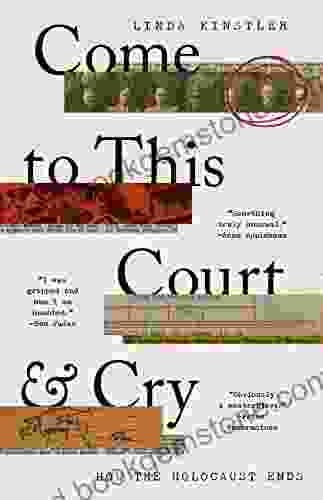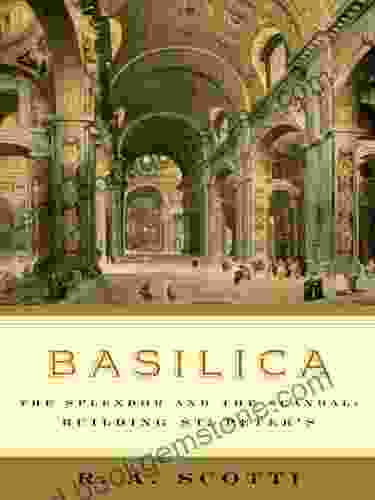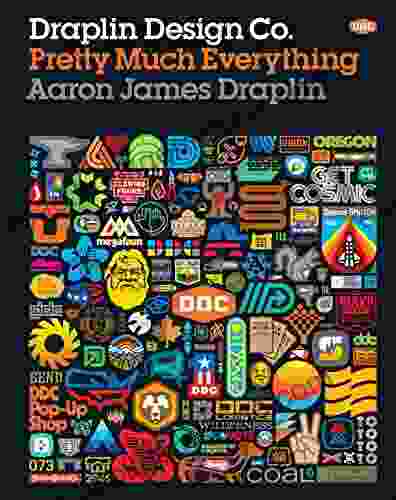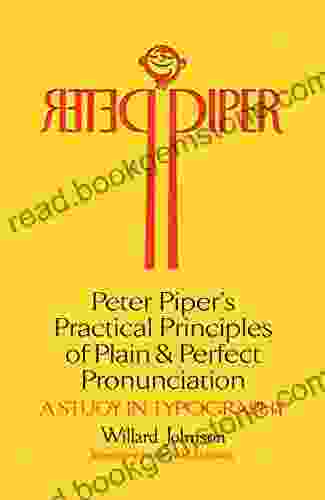Study in Typography: Unveiling the Art of Lettering, Calligraphy, and Typography

4 out of 5
| Language | : | English |
| File size | : | 7969 KB |
| Text-to-Speech | : | Enabled |
| Enhanced typesetting | : | Enabled |
| Lending | : | Enabled |
| Screen Reader | : | Supported |
| Print length | : | 112 pages |
Typography, the art of arranging and designing letters, is a captivating art form that combines aesthetics and function. From the ethereal beauty of calligraphy to the precise strokes of typography, this multifaceted discipline plays a crucial role in communication and expression. Join us on an immersive journey into the world of typography, exploring its foundational principles, historical influences, and practical applications.
Historical Roots of Typography
The Birth of Calligraphy
The origins of typography can be traced back to the ancient art of calligraphy, the manual writing of letters. Skilled scribes meticulously crafted elegant scripts on parchment and papyrus, transforming language into visually stunning works of art. The development of calligraphy flourished in various cultures, giving rise to distinct calligraphic styles such as Arabic, Chinese, and Western calligraphy.
The Invention of Printing
The invention of the printing press by Johannes Gutenberg in the 15th century revolutionized typography. The ability to mass-produce printed materials made books and other printed works more accessible, leading to a proliferation of typography and the dissemination of knowledge. Early printers experimented with different typefaces, creating a wide range of typographic styles that continue to influence contemporary design.
Foundational Principles of Typography
Anatomy of a Letterform
Understanding the anatomy of a letterform is essential in typography. Each letter is composed of various elements, including strokes, serifs, ascenders, and descenders. These elements contribute to the overall shape, legibility, and aesthetic appeal of a typeface.
Hierarchy and Legibility
Hierarchy refers to the visual arrangement of text to create emphasis and organization. Typography plays a crucial role in establishing hierarchy through font size, weight, and color. Legibility ensures that text is easily readable and comprehensible, considering factors such as font choice, line length, and spacing.
Kerning and Tracking
Kerning and tracking are techniques used to adjust the spacing between individual letters and words. Kerning refines the space between specific letter pairs, while tracking adjusts the overall spacing of a block of text. These techniques enhance the visual balance and readability of typography.
Practical Applications of Typography
Typography in Design
Typography is an integral element of graphic design and web design. It conveys information, establishes tone, and creates a memorable brand identity. Typographic choices can influence the overall aesthetic appeal, readability, and user experience of a design.
Typography in Marketing
In marketing and advertising, typography plays a vital role in capturing attention, communicating brand messages, and influencing consumer behavior. Typography can elicit emotions, create a sense of urgency, and enhance the persuasiveness of marketing campaigns.
Typography in Education
Typography is an essential tool in education, facilitating the dissemination of knowledge and promoting effective communication. Well-designed typography enhances the readability and comprehension of educational materials, making learning more accessible and engaging.
Dover on Lettering, Calligraphy and Typography
Dover Publications is renowned for its extensive collection of books on art, design, and typography. Among their notable publications are:
- Lettering and Calligraphy: A Complete Guide by Hermann Zapf: A comprehensive reference guide covering the history, techniques, and styles of lettering and calligraphy.
- Typography: An Encyclopedic Survey of Type Design and Techniques by Theo Rehak: An authoritative encyclopedia providing a comprehensive overview of typography, typefaces, and typographic principles.
- A Treasury of Alphabets and Lettering by J. I. Biegeleisen: A collection of over 1,000 alphabets and lettering styles from various cultures and time periods.
Inspiration and Resources
Exploring typography goes beyond theoretical knowledge. Immersing yourself in the world of typography through inspiration and practical experimentation is essential for growth. Here are some resources to fuel your typographic journey:
- Typographic Museums and Exhibitions: Visit museums dedicated to typography to experience historical artifacts and learn about the evolution of type design.
- Typography Magazines and Publications: Subscribe to magazines and follow online publications that showcase typographic trends, interviews with renowned typographers, and case studies of innovative typographic applications.
- Online Typography Communities: Engage with vibrant online communities where you can connect with typographers, share knowledge, and seek feedback on your work.
- Typography Software: Explore industry-standard typography software to practice your skills and experiment with different typefaces and typographic techniques.
The study of typography is an ongoing journey that combines artistic expression with practical application. By understanding the foundational principles, historical influences, and diverse practical applications of typography, you can harness this powerful art form to create visually stunning and meaningful communication. Whether you are a seasoned designer, an aspiring typographer, or simply appreciate the beauty of letters, I invite you to delve into the captivating world of typography and unlock its transformative power.
4 out of 5
| Language | : | English |
| File size | : | 7969 KB |
| Text-to-Speech | : | Enabled |
| Enhanced typesetting | : | Enabled |
| Lending | : | Enabled |
| Screen Reader | : | Supported |
| Print length | : | 112 pages |
Do you want to contribute by writing guest posts on this blog?
Please contact us and send us a resume of previous articles that you have written.
 Best Book
Best Book Page Flip
Page Flip Bookshelf
Bookshelf Literary loom
Literary loom Chapter
Chapter Bookish
Bookish PageTurner
PageTurner Bibliophile
Bibliophile Story
Story Inkwell
Inkwell Bookworm
Bookworm Labyrinth
Labyrinth Plot Twist
Plot Twist Prose
Prose Paperback
Paperback Storyteller
Storyteller Sanctuary
Sanctuary Fiction
Fiction Reading
Reading Chronicle
Chronicle Read
Read Deborah Hay
Deborah Hay Soraya French
Soraya French Julian Barnes
Julian Barnes James Abell
James Abell Tom Cotter
Tom Cotter Emily Gosling
Emily Gosling Aimee Song
Aimee Song Fernanda Melchor
Fernanda Melchor Weijian Shan
Weijian Shan Anne Strathie
Anne Strathie Brandon Ellis
Brandon Ellis Gerald Shea
Gerald Shea Tenzin Priyadarshi
Tenzin Priyadarshi Maggie Black
Maggie Black A Sanguineti
A Sanguineti Thomas Lockwood
Thomas Lockwood Vicky Unwin
Vicky Unwin A J Finn
A J Finn David Elliot Cohen
David Elliot Cohen Theophilus Monroe
Theophilus Monroe Michael Bierut
Michael Bierut James Willard Schultz
James Willard Schultz A F Kay
A F Kay Peter Cozzens
Peter Cozzens Jit Baral
Jit Baral Barbara Barrett
Barbara Barrett Bruce Scivally
Bruce Scivally Delia Gray Durant
Delia Gray Durant Charles Bowden
Charles Bowden Laura Lee Fritz
Laura Lee Fritz Elizabeth Strout
Elizabeth Strout Ray Balkwill
Ray Balkwill Donald Bogle
Donald Bogle Troy Denning
Troy Denning Ben Ryan
Ben Ryan Nigel Cross
Nigel Cross Soon Y Warren
Soon Y Warren Peter A Koenig
Peter A Koenig Sambou Kamissoko
Sambou Kamissoko Tracey Cohen
Tracey Cohen David Hornung
David Hornung Mary Kubica
Mary Kubica Cecelia Dowdy
Cecelia Dowdy Nathan Brown
Nathan Brown Greydon Clark
Greydon Clark Casey Gerald
Casey Gerald Maisy Card
Maisy Card Cazzie David
Cazzie David Christopher L Cirillo
Christopher L Cirillo Joshua Samuel Brown
Joshua Samuel Brown Mo Yan
Mo Yan Patricia Bjaaland Welch
Patricia Bjaaland Welch Mary Jane Houlton
Mary Jane Houlton Valeria Luiselli
Valeria Luiselli William Bennet Stevenson
William Bennet Stevenson Eduardo F Calcines
Eduardo F Calcines Isabella Decarlo
Isabella Decarlo Chris Backe
Chris Backe Susan Veness
Susan Veness David Hinton
David Hinton Alexandre Roger
Alexandre Roger Stephanie Thornton
Stephanie Thornton Mark J Rose
Mark J Rose Marina Berkovich
Marina Berkovich Mark Dery
Mark Dery Alyssa Cole
Alyssa Cole William Middleton
William Middleton Sheila Weller
Sheila Weller 1st Ed 2018 Edition Kindle Edition
1st Ed 2018 Edition Kindle Edition Adam Bray
Adam Bray Dani Cavallaro
Dani Cavallaro Julia Elizabeth Sloan
Julia Elizabeth Sloan Benedict Jacka
Benedict Jacka A C Crispin
A C Crispin Jo Charnock
Jo Charnock Natasha Sims
Natasha Sims Tom Sullivan
Tom Sullivan Kira Salak
Kira Salak Doug Risner
Doug Risner Bill Gardner
Bill Gardner Susie Kalil
Susie Kalil Carma Gorman
Carma Gorman Trevor Boffone
Trevor Boffone David Parker
David Parker Bernie Schein
Bernie Schein Christine Skwiot
Christine Skwiot Terrance Mulloy
Terrance Mulloy Editors Of Creative Publishing International
Editors Of Creative Publishing International Lindsay Buroker
Lindsay Buroker Paul Norbury
Paul Norbury Carlos Simpson
Carlos Simpson Elsebeth Lavold
Elsebeth Lavold Rosalind Rosenberg
Rosalind Rosenberg Ethan De Seife
Ethan De Seife Jeffrey Eugenides
Jeffrey Eugenides Rhys Bowen
Rhys Bowen Cynthia Sax
Cynthia Sax Matthew Poehler
Matthew Poehler Kelly Mills
Kelly Mills Shannon Pemrick
Shannon Pemrick Tony Corden
Tony Corden Jack Hunt
Jack Hunt Elizabeth Currie
Elizabeth Currie David Sipress
David Sipress Elizabeth Kendall
Elizabeth Kendall Sylvia D Lynch
Sylvia D Lynch Raymond Goodburn
Raymond Goodburn Stephen Farthing
Stephen Farthing Jay Boyce
Jay Boyce Jeffrey Ford
Jeffrey Ford Rocky Nielsen
Rocky Nielsen Laura Shumaker
Laura Shumaker Jennifer Natalya Fink
Jennifer Natalya Fink Stephen Baxter
Stephen Baxter Janice Dean Willis
Janice Dean Willis Simon Scarrow
Simon Scarrow Sylvester Murray
Sylvester Murray Clint Salter
Clint Salter Victor Godinez
Victor Godinez Jessica Augustsson
Jessica Augustsson Mel Laytner
Mel Laytner Gay Talese
Gay Talese Winki
Winki Dami Lee
Dami Lee Nick Athanas
Nick Athanas Jane Alexander
Jane Alexander Ray Loriga
Ray Loriga Sabra Waldfogel
Sabra Waldfogel Garry Apgar
Garry Apgar Paul C Middleton
Paul C Middleton Calvin Tomkins
Calvin Tomkins Todd Mcgowan
Todd Mcgowan A A Villescas
A A Villescas Jeffrey Wilson
Jeffrey Wilson Yvonne Wakefield
Yvonne Wakefield Insight Traveller
Insight Traveller Cixin Liu
Cixin Liu Leonard Peltier
Leonard Peltier Erwin Rosenthal
Erwin Rosenthal Diana Marcum
Diana Marcum Alberta Arthurs
Alberta Arthurs Maxim D Shrayer
Maxim D Shrayer Beth Reiber
Beth Reiber Lakia
Lakia Joanna Merlin
Joanna Merlin Belinda Jones
Belinda Jones Robert S Birchard
Robert S Birchard Ernest Chesneau
Ernest Chesneau A S Byatt
A S Byatt Aisling Juanjuan Shen
Aisling Juanjuan Shen Alison Bechdel
Alison Bechdel Gregory Crouch
Gregory Crouch Aaron James Draplin
Aaron James Draplin Daniel Tudor
Daniel Tudor Bob Sehlinger
Bob Sehlinger Shemer Kuznits
Shemer Kuznits Christopher Ruocchio
Christopher Ruocchio Marlon James
Marlon James Bob Chapman
Bob Chapman Harry Turtledove
Harry Turtledove Porsha Williams
Porsha Williams Ken Liu
Ken Liu Kamo
Kamo Joseph Farrell
Joseph Farrell David Newton
David Newton Guidora Team
Guidora Team Shana Vanterpool
Shana Vanterpool Christopher Fowler
Christopher Fowler Alta Macadam
Alta Macadam Charissa N Terranova
Charissa N Terranova Joanna Kulesza
Joanna Kulesza A M Sohma
A M Sohma Marina Abramovic
Marina Abramovic Andrew Crone
Andrew Crone Roger Williams
Roger Williams Robert Shufflebotham
Robert Shufflebotham Sara Novic
Sara Novic Shantiana Cooper
Shantiana Cooper Jeremy Hicks
Jeremy Hicks Ruth Millington
Ruth Millington Michael Brooke
Michael Brooke Carl Little
Carl Little Mark Greaney
Mark Greaney A P Bateman
A P Bateman E Train Learning
E Train Learning Dale Sherman
Dale Sherman Kenneth Clark
Kenneth Clark Ann Fensterstock
Ann Fensterstock A Desaint
A Desaint Tonya Burrows
Tonya Burrows Lisa Jackson
Lisa Jackson Michael A Almond
Michael A Almond Deby Coles
Deby Coles Joan Wiener Bordow
Joan Wiener Bordow Aabis Johnson
Aabis Johnson Daniel Van
Daniel Van Leslie Cabarga
Leslie Cabarga Linda Kinstler
Linda Kinstler Andres Lopez
Andres Lopez Lina Chang
Lina Chang Tommaso Astarita
Tommaso Astarita Nicole Koetter
Nicole Koetter Dean Simmons
Dean Simmons Dawn Loring
Dawn Loring Tori Harris
Tori Harris Bob Kaufman
Bob Kaufman Pierre Alex Jeanty
Pierre Alex Jeanty Megan Goldmine
Megan Goldmine Karin Tanabe
Karin Tanabe Charles Barr
Charles Barr Belle Yang
Belle Yang Alexander William Kinglake
Alexander William Kinglake Jarrett Wrisley
Jarrett Wrisley Alex W White
Alex W White Donald Richie
Donald Richie Carrie Prudence Winter
Carrie Prudence Winter Seth Ring
Seth Ring Aaron Barron
Aaron Barron Paolo Hewitt
Paolo Hewitt Danielle Ofri
Danielle Ofri Lisa Rose Wright
Lisa Rose Wright A K Duboff
A K Duboff J B Bobo
J B Bobo W David Baird
W David Baird Richard Wagamese
Richard Wagamese Jonathan Harr
Jonathan Harr Madeleine Korbel Albright
Madeleine Korbel Albright Scott Lunt
Scott Lunt C C Alma
C C Alma Mary Gabriel
Mary Gabriel Joseph D Addetta
Joseph D Addetta Glennon Doyle
Glennon Doyle 3dtotal Publishing
3dtotal Publishing Birnbaum Guides
Birnbaum Guides Paraluman S Aspillera
Paraluman S Aspillera Steve Kaffen
Steve Kaffen Sarah Noffke
Sarah Noffke John Hopkins
John Hopkins Marie Arana
Marie Arana Justin Catanoso
Justin Catanoso K Reynolds James
K Reynolds James Cora Harrington
Cora Harrington Jeff A Menges
Jeff A Menges Jennifer Rosner
Jennifer Rosner S M Warlow
S M Warlow Bill Robinson
Bill Robinson Charles Foran
Charles Foran Pete Buckley
Pete Buckley Bruce Sentar
Bruce Sentar Laurence Matthews
Laurence Matthews Reed Tucker
Reed Tucker Michael F Keaney
Michael F Keaney Luis Tiant
Luis Tiant Robert E Kapsis
Robert E Kapsis Ranim Nourallah
Ranim Nourallah Jules Gailhabaud
Jules Gailhabaud Shvonne Latrice
Shvonne Latrice Jihyun Park
Jihyun Park Mamie Till Mobley
Mamie Till Mobley David Bergsland
David Bergsland R H Sin
R H Sin Thais Riotto
Thais Riotto Andy Fletcher
Andy Fletcher John F Callahan
John F Callahan Stephen Haddelsey
Stephen Haddelsey Joel Paul Reisig
Joel Paul Reisig Shawna Sharee
Shawna Sharee Goddess Love
Goddess Love Bernardine Evaristo
Bernardine Evaristo Richard F Fleck
Richard F Fleck James M Mcpherson
James M Mcpherson Stephen Chambers
Stephen Chambers David Batchelor
David Batchelor Robyn Wideman
Robyn Wideman Dannion Brinkley
Dannion Brinkley Annalyn Swan
Annalyn Swan Rose Gonnella
Rose Gonnella Aaron Bobrow Strain
Aaron Bobrow Strain Fred Arroyo
Fred Arroyo Victor Margolin
Victor Margolin Maureen Egan
Maureen Egan Scott Peters
Scott Peters Gary Phillips
Gary Phillips Maria Sibylla Merian
Maria Sibylla Merian Victor Steffensen
Victor Steffensen Lynn Michelsohn
Lynn Michelsohn Dave Willmarth
Dave Willmarth Tarana Burke
Tarana Burke Joseph M Mascia
Joseph M Mascia Stan Zimmerman
Stan Zimmerman V S Naipaul
V S Naipaul Andy Clark
Andy Clark Kathleen Jones
Kathleen Jones Actus
Actus Paul Austin Ardoin
Paul Austin Ardoin Tao Wong
Tao Wong Larry Niven
Larry Niven Andrew Forkner
Andrew Forkner Lewis Hyde
Lewis Hyde Phyllis Birnbaum
Phyllis Birnbaum Morgan Jerkins
Morgan Jerkins A J Alonzo Wind
A J Alonzo Wind Stephen Powell
Stephen Powell Salvador Dali
Salvador Dali Peter Rush
Peter Rush Rebecca Dwight Bruff
Rebecca Dwight Bruff Sam Tranum
Sam Tranum S L Partee
S L Partee Meyer Levin
Meyer Levin Marjorie Lambert
Marjorie Lambert Gregory Mirow
Gregory Mirow John D Gartner
John D Gartner Alison C Board
Alison C Board Neil Hutchison
Neil Hutchison Mary Prince
Mary Prince Reginald Fleming Johnston
Reginald Fleming Johnston Lisa Maker
Lisa Maker Sam J Miller
Sam J Miller Amarilys Henderson
Amarilys Henderson Brandi Carlile
Brandi Carlile Brandon Sanderson
Brandon Sanderson Chris Robinson
Chris Robinson Terence Biffi
Terence Biffi J M Phillips
J M Phillips Natasha Lawyer
Natasha Lawyer Olympia Black
Olympia Black Lawrence F Lihosit
Lawrence F Lihosit Elena Ferro
Elena Ferro K Kris Loomis
K Kris Loomis Michael Petrou
Michael Petrou Ron Mcninch
Ron Mcninch Jeffrey Alford
Jeffrey Alford Collins Uk
Collins Uk Judy O Haselhoef
Judy O Haselhoef Ann Fisher
Ann Fisher David Gentleman
David Gentleman Linea Johnson
Linea Johnson Giorgia Lupi
Giorgia Lupi Anne Wheeler
Anne Wheeler Dave Austin
Dave Austin A D Davies
A D Davies Colin Post
Colin Post Margo Bond Collins
Margo Bond Collins Trice Hickman
Trice Hickman Sarah Bird
Sarah Bird Jane M Newby
Jane M Newby Zen Cho
Zen Cho Javier Zamora
Javier Zamora Noah Scalin
Noah Scalin Shelly Culbertson
Shelly Culbertson Catie Marron
Catie Marron A American
A American Sean Willson
Sean Willson Jennifer Bohnet
Jennifer Bohnet Julia Whelan
Julia Whelan Tina Martin
Tina Martin James Just
James Just Gautam Raghavan
Gautam Raghavan Gail Lukasik
Gail Lukasik Dean Wesley Smith
Dean Wesley Smith Shira Lipkin
Shira Lipkin Bruce Carroll
Bruce Carroll Jon Tucker
Jon Tucker Sarah Fraser
Sarah Fraser Laurie Gwen Shapiro
Laurie Gwen Shapiro Barbara Newton
Barbara Newton Ted Riese
Ted Riese Audre Lorde
Audre Lorde Brittany Gibbons
Brittany Gibbons Jenny Mcgill
Jenny Mcgill Hilary Hughes Loftus
Hilary Hughes Loftus Sharon Shinn
Sharon Shinn Toby Neighbors
Toby Neighbors Koichi Hagawa
Koichi Hagawa Sean Michael Andrews
Sean Michael Andrews Bridget Quinn
Bridget Quinn Kate Clair
Kate Clair Catherine Kapphahn
Catherine Kapphahn Paul R Wonning
Paul R Wonning Darren Royston
Darren Royston Gary Orleck
Gary Orleck Paul Daugherty
Paul Daugherty Richard Condit
Richard Condit Agathe Singer
Agathe Singer Larry Moss
Larry Moss Michael C Grumley
Michael C Grumley Kaylie Kay
Kaylie Kay Catherine Belsey
Catherine Belsey Ann Patchett
Ann Patchett David Nabhan
David Nabhan C J Cherryh
C J Cherryh Charles Johnson
Charles Johnson Megan Mackie
Megan Mackie Don Croner
Don Croner Mari Sandoz
Mari Sandoz Aaris Sherin
Aaris Sherin Greg Sarris
Greg Sarris Alex Stone
Alex Stone Jesse Day
Jesse Day Stanley Green
Stanley Green Roman Plesky
Roman Plesky John Marmysz
John Marmysz Bwwm Club
Bwwm Club Daniel Gordis
Daniel Gordis Erin Khar
Erin Khar Luther Standing Bear
Luther Standing Bear Shellise Berry
Shellise Berry Natasha Brown
Natasha Brown J T Brannan
J T Brannan David Cousens
David Cousens Sarah Torrecillas
Sarah Torrecillas Richard Kaufman
Richard Kaufman Peter Swanson
Peter Swanson Victoria Buitron
Victoria Buitron Debra Meyerson
Debra Meyerson Burt Wrenlaw
Burt Wrenlaw Gary David Bouton
Gary David Bouton Christopher Ingraham
Christopher Ingraham Leatrice Eiseman
Leatrice Eiseman Mark Harris
Mark Harris Michael Crichton
Michael Crichton Ava Ross
Ava Ross A R Burns
A R Burns Peter Watts
Peter Watts Julie Metz
Julie Metz Michelle Vogel
Michelle Vogel Nikki Giovanni
Nikki Giovanni Scotia Gilroy
Scotia Gilroy Gary Heath
Gary Heath Henry Dreyfuss
Henry Dreyfuss 2nd Edition Kindle Edition
2nd Edition Kindle Edition Shaa Fazal
Shaa Fazal Ina Knobloch
Ina Knobloch A R Corbin
A R Corbin Joe Upton
Joe Upton Merick N H Ulrik
Merick N H Ulrik Daniel Jacobs
Daniel Jacobs Charles Harrison
Charles Harrison Arnold Lowrey
Arnold Lowrey Laura J Mixon
Laura J Mixon Nick Jones
Nick Jones Henry White
Henry White Margo Porras
Margo Porras Fred Crellin
Fred Crellin R A Scotti
R A Scotti Partha Mitter
Partha Mitter Koloman Moser
Koloman Moser Tony Barr
Tony Barr David Lewis
David Lewis William F Powell
William F Powell Ernest R Norling
Ernest R Norling William O Connor
William O Connor Juliet Rieden
Juliet Rieden Zoe Ingram
Zoe Ingram Yihui Xie
Yihui Xie Carol Boyle
Carol Boyle Dean Dalton
Dean Dalton Phylis Johnson
Phylis Johnson Nanna Katrine Luders Kaalund
Nanna Katrine Luders Kaalund C Napier Bell
C Napier Bell Helen Raleigh
Helen Raleigh Yanis Varoufakis
Yanis Varoufakis Tim Lebbon
Tim Lebbon Douglas Dorow
Douglas Dorow Shirlene Obuobi
Shirlene Obuobi Jane Allen Petrick
Jane Allen Petrick Dustin Stevens
Dustin Stevens Karen Speerstra
Karen Speerstra Thom Wall
Thom Wall John Christian Hopkins
John Christian Hopkins Laura L Engel
Laura L Engel Diego Enrique Osorno
Diego Enrique Osorno Rachel Woods
Rachel Woods Jhumpa Lahiri
Jhumpa Lahiri Jung Yun
Jung Yun Melissa Fu
Melissa Fu Edmund De Waal
Edmund De Waal Marina Jarre
Marina Jarre Ralph Ellison
Ralph Ellison Nek Hickmon
Nek Hickmon Tony Spawforth
Tony Spawforth Mazie K Hirono
Mazie K Hirono John E Siers
John E Siers Melverna Mcfarlane
Melverna Mcfarlane Steve Gladstone
Steve Gladstone Dean C Moore
Dean C Moore Amanda Conner
Amanda Conner Jeff Howard
Jeff Howard J C Cannell
J C Cannell Derek Hough
Derek Hough Renato Perdon
Renato Perdon Eddie Lennon
Eddie Lennon Jenell Diegor
Jenell Diegor Beate Sirota Gordon
Beate Sirota Gordon Bill Neeley
Bill Neeley Gustavo Arellano
Gustavo Arellano Jan Gaye
Jan Gaye Alastair Campbell
Alastair Campbell Joseph Q Jarvis
Joseph Q Jarvis Michael Roberts
Michael Roberts Diana K Schwam
Diana K Schwam R Allen Hardy
R Allen Hardy Jennifer Melville
Jennifer Melville Anuj Tikku
Anuj Tikku Rebecca Vincent
Rebecca Vincent Robert Fleming
Robert Fleming Mosy Brigth
Mosy Brigth Neil A Hogan
Neil A Hogan Trevor Norton
Trevor Norton Shannon Leone Fowler
Shannon Leone Fowler Penelope Douglas
Penelope Douglas Chris Bond
Chris Bond Tricia Martineau Wagner
Tricia Martineau Wagner Charles Alexander Eastman
Charles Alexander Eastman Sam Hampton Smith
Sam Hampton Smith Gary Earl Ross
Gary Earl Ross Alex Kosh
Alex Kosh Heather Young
Heather Young Rowland B Wilson
Rowland B Wilson Michelle Knight
Michelle Knight Darra Goldstein
Darra Goldstein Walter Crane
Walter Crane Kitiara Pascoe
Kitiara Pascoe Jack Womack
Jack Womack Brad Warner
Brad Warner Nawar Shora
Nawar Shora James Robert
James Robert Cynthia Knox
Cynthia Knox Andre Iguodala
Andre Iguodala Donna Digiuseppe
Donna Digiuseppe 1st Ed 2019 Edition Kindle Edition
1st Ed 2019 Edition Kindle Edition Monica Peach
Monica Peach Michael Gross
Michael Gross James Egan
James Egan Harmony Bench
Harmony Bench Karen Haid
Karen Haid Maud Fontenoy
Maud Fontenoy Heinrich Klutschak
Heinrich Klutschak Rosemary Edghill
Rosemary Edghill Janice Cavell
Janice Cavell Edward Leo
Edward Leo Dk
Dk Kate Sekules
Kate Sekules Aaron Dembski Bowden
Aaron Dembski Bowden Maryanne Peters
Maryanne Peters Lisa Ohlen Harris
Lisa Ohlen Harris Negar Mottahedeh
Negar Mottahedeh Paul Hill
Paul Hill Etienne De Backer
Etienne De Backer Heather Webb
Heather Webb Brian J Robb
Brian J Robb David Blacklock
David Blacklock Kathy Arlyn Sokol
Kathy Arlyn Sokol Roberta Milliken
Roberta Milliken Selena Montgomery
Selena Montgomery Clive Cussler
Clive Cussler Tyrel Nelson
Tyrel Nelson Donald B Mcfarlane
Donald B Mcfarlane Kate Clifford Larson
Kate Clifford Larson J D Sullivan
J D Sullivan Jeaniene Frost
Jeaniene Frost Graham Fraser
Graham Fraser John Edson
John Edson John Cheever
John Cheever Walter Jon Williams
Walter Jon Williams James Osiris Baldwin
James Osiris Baldwin Ramze Suliman
Ramze Suliman Leo Kahl
Leo Kahl Daniel Mathews
Daniel Mathews Samantha Seiple
Samantha Seiple Dale Brown
Dale Brown Gary O Neal
Gary O Neal Jen Santos
Jen Santos Brian Morton
Brian Morton Noah Brooks
Noah Brooks Mark Jones
Mark Jones Brad Thor
Brad Thor M N Forgy
M N Forgy John Gimlette
John Gimlette Daniel Sheets Dye
Daniel Sheets Dye Tania Romanov
Tania Romanov Danny Garcia
Danny Garcia Richard Taylor
Richard Taylor Michael Wigge
Michael Wigge S E Smith
S E Smith Dwight Roth
Dwight Roth A C Arthur
A C Arthur Aaron Fine
Aaron Fine Henri Piquer
Henri Piquer Philippe Chantepie
Philippe Chantepie Juno Wells
Juno Wells Mary Jane Walker
Mary Jane Walker Octavia E Butler
Octavia E Butler Ayano Otani
Ayano Otani Douglas E Richards
Douglas E Richards Rich Horton
Rich Horton David Feintuch
David Feintuch A Michael Shumate
A Michael Shumate 1st Edition Kindle Edition
1st Edition Kindle Edition Jill Santopolo
Jill Santopolo Nick Iuppa
Nick Iuppa Robin Barratt
Robin Barratt Christa Upton
Christa Upton Suyi Davies Okungbowa
Suyi Davies Okungbowa R W W Greene
R W W Greene Roxie Mcclaine
Roxie Mcclaine T Ann Marie
T Ann Marie Bryony Gomez Palacio
Bryony Gomez Palacio Martin Fletcher
Martin Fletcher Susan R Barry
Susan R Barry Kresley Cole
Kresley Cole Catherine Grace Katz
Catherine Grace Katz Leesa Cross Smith
Leesa Cross Smith Cyrus Massoudi
Cyrus Massoudi David Garner
David Garner M P Woodward
M P Woodward Ann V Winterbotham
Ann V Winterbotham Kate Langbroek
Kate Langbroek Blake Gopnik
Blake Gopnik Tara Bray Smith
Tara Bray Smith Aileen Bordman
Aileen Bordman Joshua Bloom
Joshua Bloom Martha Wainwright
Martha Wainwright Brant Antonson
Brant Antonson Chris Hechtl
Chris Hechtl Dmitry Samarov
Dmitry Samarov Brette Sember
Brette Sember Christopher James
Christopher James
Light bulbAdvertise smarter! Our strategic ad space ensures maximum exposure. Reserve your spot today!

 Michael SimmonsYou'll Forget This Ever Happened: A Deep Dive into the Psychological Impact...
Michael SimmonsYou'll Forget This Ever Happened: A Deep Dive into the Psychological Impact...
 Fernando BellUntil You Fall Away Series: A Detailed Exploration of a Captivating Literary...
Fernando BellUntil You Fall Away Series: A Detailed Exploration of a Captivating Literary... Wayne CarterFollow ·5.7k
Wayne CarterFollow ·5.7k Ryan FosterFollow ·7.3k
Ryan FosterFollow ·7.3k Allen ParkerFollow ·7k
Allen ParkerFollow ·7k E.M. ForsterFollow ·12.4k
E.M. ForsterFollow ·12.4k Gene PowellFollow ·7.7k
Gene PowellFollow ·7.7k Mikhail BulgakovFollow ·17.3k
Mikhail BulgakovFollow ·17.3k Graham BlairFollow ·10.1k
Graham BlairFollow ·10.1k Gary ReedFollow ·8.4k
Gary ReedFollow ·8.4k

 Lucas Reed
Lucas ReedFantasy Technology and Politics: A Deep Dive into the...
Fantasy literature...

 Blake Kennedy
Blake KennedyCome To This Court And Cry: A Tale of Love, Loss, and...
Come To This Court And Cry...

 Kendall Ward
Kendall WardThe Majestic Edifice: Exploring the History and...
St. Peter's Basilica, an architectural...

 Emmett Mitchell
Emmett MitchellDraplin Design Co.: Pretty Much Everything
Who is Draplin Design Co.? Draplin Design...

 Eliot Foster
Eliot FosterUnveiling the Enthralling Literary Cosmos of Against Time...
Prologue: A Quantum Nexus of Time and...

 Connor Mitchell
Connor MitchellMy Journey Through the Labyrinth of Low-Budget...
In the enthralling realm of filmmaking,...
4 out of 5
| Language | : | English |
| File size | : | 7969 KB |
| Text-to-Speech | : | Enabled |
| Enhanced typesetting | : | Enabled |
| Lending | : | Enabled |
| Screen Reader | : | Supported |
| Print length | : | 112 pages |








